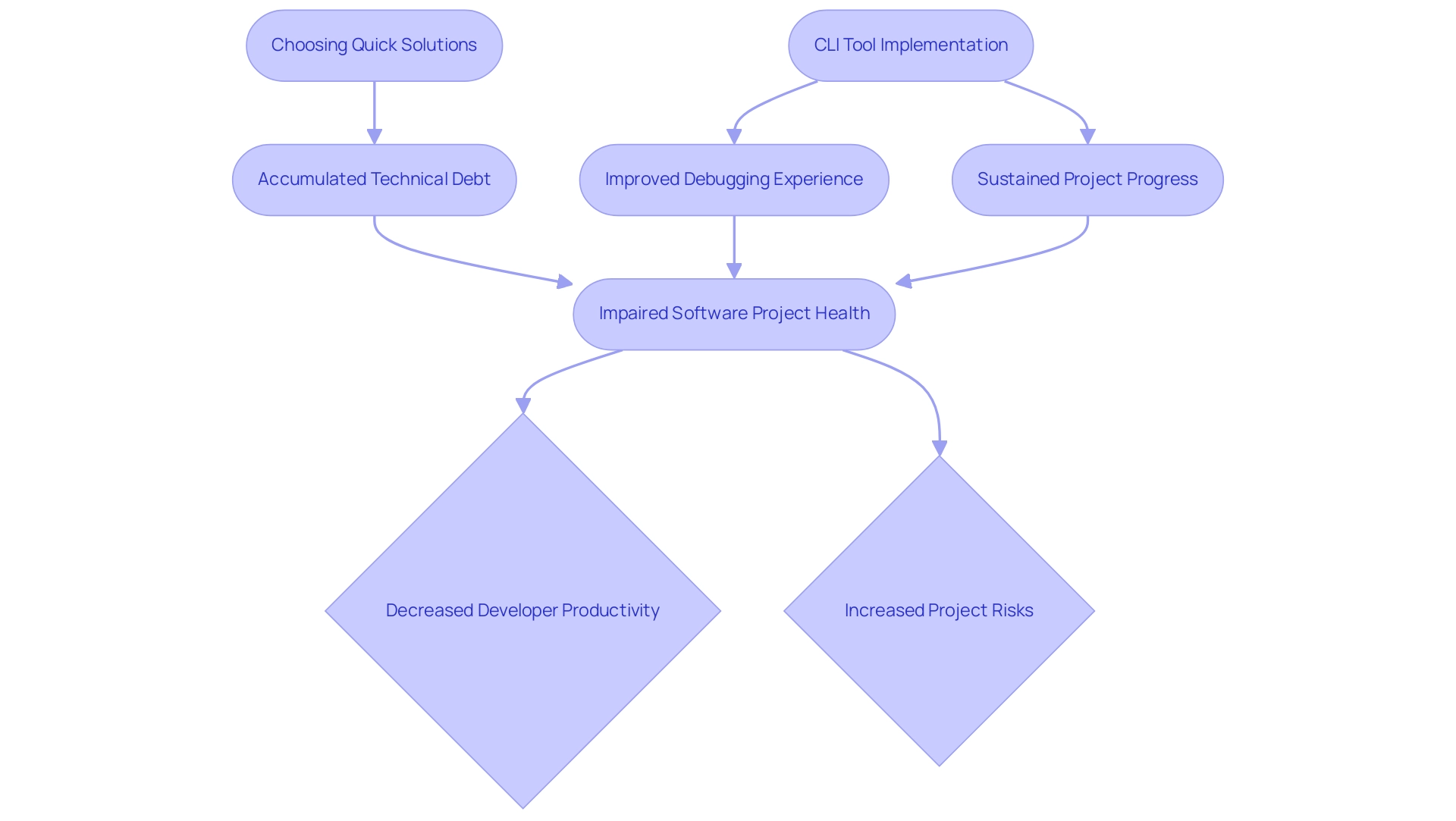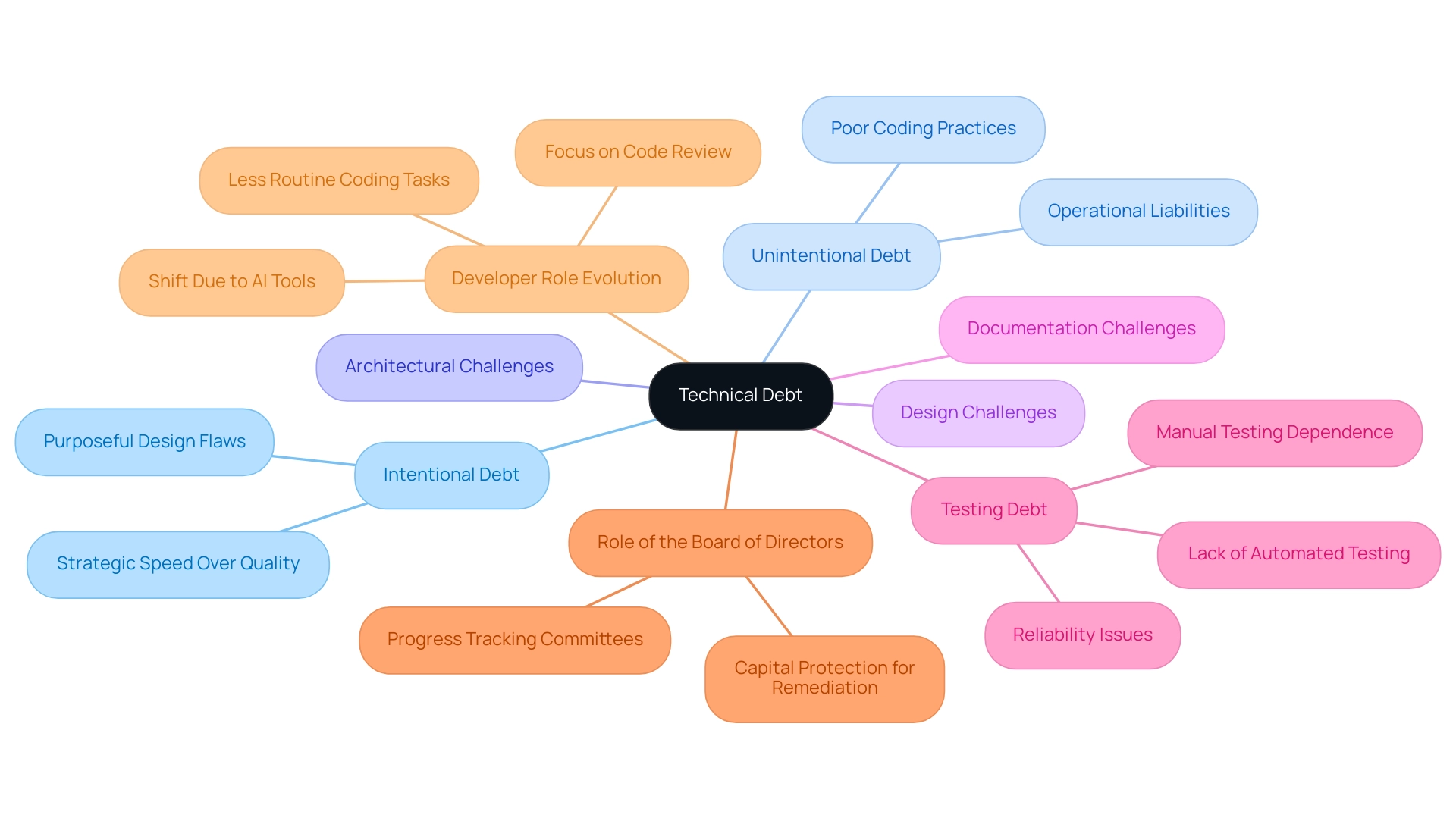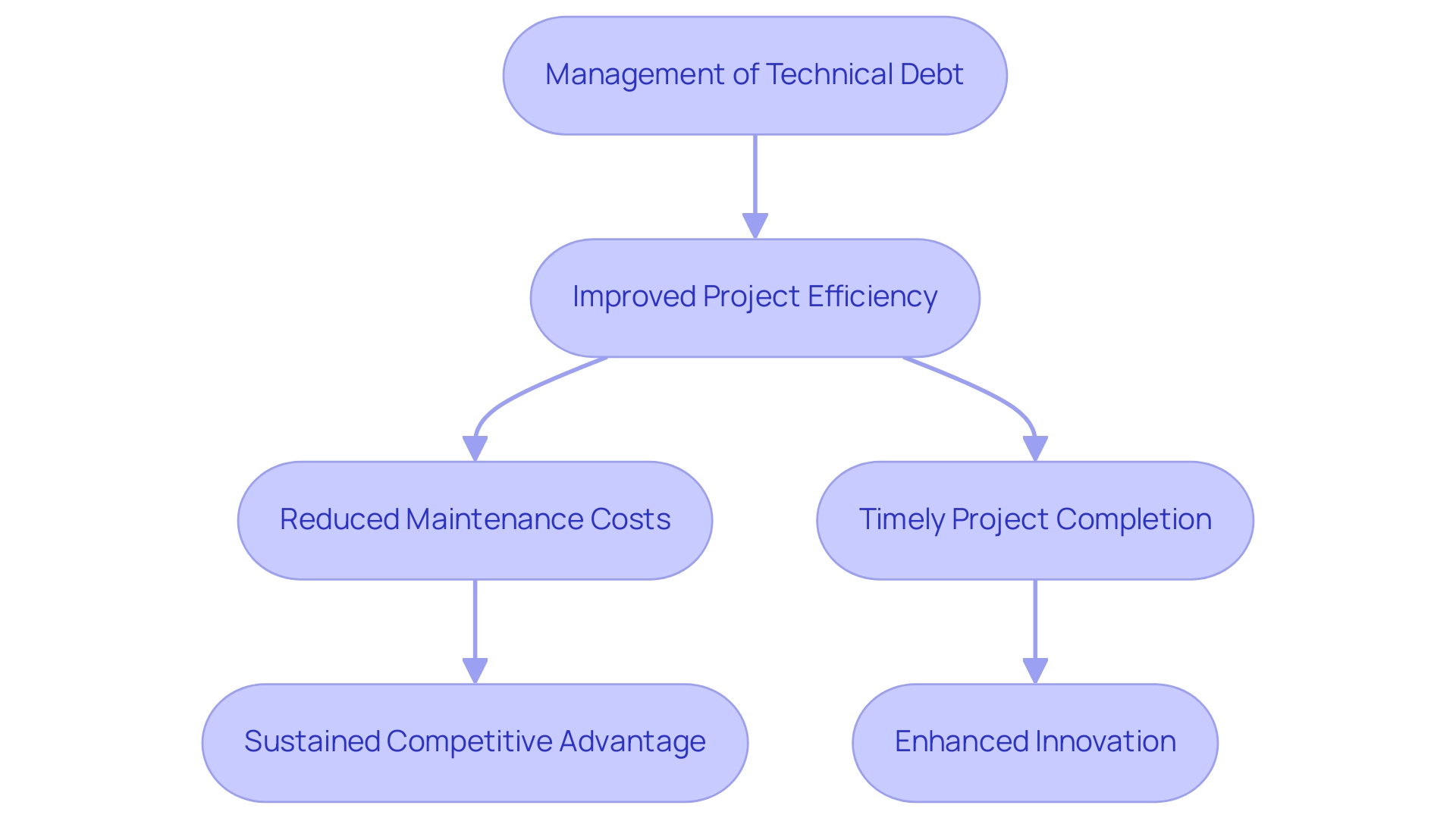Overview
Technical debt refers to the implied costs of rework that arise from choosing quick, limited solutions over more comprehensive approaches, which can lead to long-term complications in software development. The article discusses how technical debt accumulates due to factors like tight deadlines and inadequate testing, ultimately resulting in increased maintenance costs and decreased efficiency, emphasizing the importance of understanding and managing these liabilities for successful project outcomes.
Introduction
In the fast-evolving landscape of software development, the concept of technical debt has emerged as a critical concern for organizations striving for efficiency and sustainability.
Initially coined by Ward Cunningham, this term encapsulates the hidden costs associated with quick fixes that may boost short-term productivity but often lead to long-term complications.
As development teams juggle tight deadlines and resource constraints, the temptation to take shortcuts can result in a backlog of unresolved issues that impede progress and inflate maintenance costs.
The ramifications of technical debt extend beyond mere coding challenges; they can derail entire projects and diminish user satisfaction.
However, innovative solutions like Kodezi CLI offer a pathway to not only identify and manage these debts but also enhance overall productivity.
By automating code improvements and debugging processes, Kodezi empowers engineering teams to transform potential pitfalls into opportunities for growth, ensuring that technical debt is managed effectively and sustainably.
Defining Technical Debt: A Comprehensive Overview
To understand what does technical debt mean, one must recognize that it encapsulates the implied costs associated with rework that arises from opting for quick, limited solutions instead of more robust approaches that require more time and resources, a term initially coined by Ward Cunningham. While such shortcuts may speed up initial stages, they often result in a buildup of unresolved issues that require attention later. This backlog can significantly impair the long-term health of software projects, complicating future development cycles and potentially jeopardizing overall project success.
As Mike Huthwaite, CIO of Hartman Executive Advisors, aptly states, 'Purposeful technological obligations have their place and value; unintentional technological burdens present a greater issue.' When we don’t monitor all the financial obligations, then you may discover you’re on the verge of bankruptcy, and understanding what does technical debt mean is crucial not only for developers but also for stakeholders, as it directly impacts productivity and efficiency. For instance, developers require large blocks of uninterrupted time for complex problem-solving and coding tasks, yet frequent interruptions and meetings disrupt this deep work, leading to decreased productivity and increased frustration.
The CLI emerges as a versatile tool for B2B engineering teams, often referred to as 'the B2B Swiss Army Knife for Engineering Teams,' addressing these challenges by autonomously improving codebases and fixing bugs before they reach production. With features like a '5-minute quickstart' and the ability to 'see a demo,' this platform enhances user experience significantly. With over 1,000,000 users, testimonials emphasize that this platform enables developers to locate and resolve bugs more quickly, effectively improving their debugging experience and overall productivity.
As one user aptly expressed, 'I love what this platform is doing with debugging; it feels like I just unlocked a new superpower!' Therefore, efficiently handling code liabilities becomes essential for sustaining project progress and attaining lasting software development results, with Kodezi playing a vital part in this process.

Understanding the Causes and Consequences of Technical Debt
Technical obligations frequently arise from a confluence of factors such as tight deadlines, budget limitations, and inadequate testing processes. Developers may resort to expedited solutions to adhere to project timelines, often at the expense of thorough implementation. The consequences of accumulating technological liabilities, which is often referred to as what does technical debt mean, can be substantial, resulting in increased maintenance expenses, reduced software performance, and ultimately, a decline in user satisfaction.
In 2024, statistics show that organizations are losing between $200 million and $300 million in quantifiable benefits due to unresolved technical debt, which raises the question of what does technical debt mean over a three- to five-year horizon. To combat this, it is crucial for teams to recognize these underlying causes and adopt improved planning and development practices, including automated testing and code reviews. Tools such as these enable codebase management through automated code debugging, allowing developers to swiftly identify and resolve issues while adhering to security compliance and coding standards.
The platform ensures that codebases adhere to the latest security best practices, aiding in the reduction of vulnerabilities and improving overall quality. Furthermore, this tool enhances productivity by providing AI-powered programming help that automatically corrects code and optimizes performance. Unlike other tools such as Copilot, which primarily focus on code completion, Kodezi acts as an autocorrect for programming, directly addressing bugs and providing detailed explanations.
High-performing companies have implemented Quarterly Business Reviews (QBRs) as a strategic tool to ensure transparency and facilitate decision-making. By evaluating progress against goals during these assessments, companies can efficiently redistribute resources to strengthen successful initiatives and tackle those that are underperforming, thus consistently providing value and reducing the long-term effects of technological shortcomings. Furthermore, the board of directors plays a crucial role in protecting capital for tech obligation remediation and tracking progress, as demonstrated by a banking group's technology subcommittee.
As Mike Huthwaite, CIO of Hartman Executive Advisors, aptly states, 'Purposeful technological obligations have their place and value; however, understanding what does technical debt mean is crucial as unintentional technological burdens present a greater issue.' This insight highlights the intricacies of handling technological liabilities, especially as organizations align themselves as cloud-native partners, making the importance of addressing these liabilities increasingly vital in the context of value-driven digital transformation.
Exploring the Types of Technical Debt
The concept of what does technical debt mean is reflected in the various forms of technical obligations, primarily categorized as intentional and unintentional. Purposeful design flaws occur when development teams intentionally prioritize speed over quality, which raises the question of what does technical debt mean for the necessary refactoring or enhancement of the code later. While this approach can be strategic, it raises the question of what does technical debt mean if it carries risks when not managed properly.
On the other hand, unintentional operational liabilities arise from oversights or gaps in knowledge, leading to poor coding practices that can accumulate over time, illustrating what does technical debt mean. Beyond these main categories, coding obligations also include architectural, design, and documentation challenges, which leads to the inquiry of what does technical debt mean, as each requires specific strategies for resolution. Here, the CLI becomes a versatile tool for B2B engineering teams attempting to auto-heal codebases and improve productivity.
By independently enhancing code quality and resolving issues before they enter production, Kodezi CLI effectively tackles both deliberate and accidental technical liabilities, highlighting what does technical debt mean. A critical aspect of managing this obligation involves the board of directors understanding what does technical debt mean, as they play a vital role in protecting capital for tech obligation remediation and tracking progress through dedicated committees. Recent studies indicate that achieving an 80% code coverage is essential for compliance, leading to the question of what does technical debt mean in relation to the need for robust automated testing frameworks to mitigate testing debt.
This statistic highlights what does technical debt mean in terms of the importance of extensive and automated testing to prevent unreliable software and reduce reliance on manual testing. Moreover, the automatic code commenting feature enhances readability and understanding across multiple programming languages, including JavaScript, Python, Java, and more, making it an invaluable asset for developers. As they adapt to AI tools, developers expect a change in their responsibilities, enabling them to concentrate less on routine coding tasks and more on reviewing and refining code.
As one unnamed developer noted, 'Less time spent writing mundane things.' This evolution may result in a more proactive strategy in handling both intentional and unintentional issues, which can ultimately enhance software quality and team efficiency, while also addressing what does technical debt mean. For those interested in getting started, Kodezi offers a 5-minute quickstart guide and a demo to showcase its capabilities.

Strategies for Managing and Reducing Technical Debt
To efficiently handle and lessen software liabilities, engineering teams can adopt a range of strategic practices. Regular code reviews are critical; they not only help identify potential issues early but also foster a culture of collaboration and accountability. Refactoring sessions should be scheduled to address areas of concern before they escalate into larger problems.
The inclusion of automated testing further improves this proactive strategy by identifying problems early in the development lifecycle, thus lowering the long-term expenses linked to technological obligations. Allocating approximately 15% of the IT budget in remediation of obligations is regarded as the most efficient method to maintain a contemporary digital core, emphasizing the financial aspect of these strategies. Agile methodologies play a crucial role as well, enabling teams to prioritize issues within their backlogs, which promotes continuous improvement.
Education is also crucial; teams need to be aware of what does technical debt mean to manage it effectively. As Matt, a dedicated developer, puts it, 'The essence of software creation lies in maintaining quality and sustainability.' Additionally, the process of estimating remediation costs allows teams to analyze the effort required to fix violations based on complexity, enabling them to prioritize effectively and make data-driven decisions.
This estimation procedure assists in comparative evaluation of remediation expenses across specialized components, helping organizations to concentrate their efforts where they are most needed.
The Business Impact of Technical Debt in Software Development
Technical liabilities can significantly influence business operations, particularly in the area of software creation. Organizations that find themselves in the bottom 20th percentile of technology burden severity face a staggering 40% higher likelihood of encountering incomplete or canceled IT modernization efforts. Significant amounts of technological obligations not only slow down development cycles but also increase maintenance expenses and obstruct innovation.
Project timelines become stretched, resource allocation is compromised, and the risk of missed deadlines and budget overruns significantly increases. As pointed out by Matt, an enthusiastic developer, grasping these implications is vital:
Efficient management of technological obligations is key for sustaining a competitive advantage in the rapidly evolving tech environment.
Moreover, the board of directors plays an essential role in safeguarding resources for remediation of issues and monitoring progress, ensuring that organizations stay responsible in their efforts.
By focusing on managing system liabilities within project structures, stakeholders can make informed choices that ultimately result in improved operational efficiency and better overall results. Incorporating continuous improvement practices into the development workflow, as shown in the case study titled 'Continuous Improvement in Technical Debt Management,' allows organizations to systematically tackle architectural issues, which raises the question of what does technical debt mean for ensuring a healthier IT infrastructure and fostering sustainable growth. Additionally, as Forrester's latest forecast predicts robust growth of 5.6% in the global technology market by 2025, it becomes increasingly important for businesses to comprehend what does technical debt mean and manage it effectively within this evolving landscape.

Conclusion
The complexities of technical debt present significant challenges for software development teams, impacting project timelines, resource allocation, and overall productivity. Understanding its origins—ranging from tight deadlines to inadequate testing—enables stakeholders to address these issues proactively. The consequences of neglecting technical debt can be severe, leading to increased maintenance costs and diminished user satisfaction.
Innovative tools like Kodezi CLI emerge as essential allies in this battle, offering automated solutions that streamline code improvement and debugging processes. By empowering developers to tackle both intentional and unintentional technical debt, Kodezi not only enhances coding efficiency but also fosters a culture of quality and sustainability within engineering teams.
As organizations navigate the fast-evolving tech landscape, prioritizing effective technical debt management becomes crucial for maintaining a competitive edge. By implementing strategic practices such as:
- Regular code reviews
- Automated testing
and leveraging advanced tools like Kodezi, companies can transform potential pitfalls into opportunities for growth. Embracing these approaches ensures that technical debt is not merely a burden but a manageable aspect of achieving sustainable software development outcomes.
Frequently Asked Questions
What is technical debt?
Technical debt refers to the implied costs associated with rework that arises when quick, limited solutions are chosen over more robust approaches that require more time and resources. This can lead to unresolved issues that impair the long-term health of software projects.
Who coined the term 'technical debt'?
The term 'technical debt' was initially coined by Ward Cunningham.
What are the consequences of accumulating technical debt?
Accumulating technical debt can result in increased maintenance expenses, reduced software performance, and a decline in user satisfaction. Organizations may lose between $200 million and $300 million in quantifiable benefits due to unresolved technical debt.
What factors contribute to the creation of technical debt?
Technical debt frequently arises from tight deadlines, budget limitations, and inadequate testing processes, leading developers to resort to expedited solutions at the expense of thorough implementation.
How can teams effectively manage technical debt?
Teams can manage technical debt by recognizing underlying causes and adopting improved planning and development practices, including automated testing and code reviews, which help in codebase management and issue resolution.
What role does the CLI platform play in managing technical debt?
The CLI platform, referred to as 'the B2B Swiss Army Knife for Engineering Teams,' autonomously improves codebases and fixes bugs before they reach production, enhancing productivity and debugging experiences for developers.
How does Kodezi differ from other programming tools like Copilot?
Kodezi acts as an autocorrect for programming, directly addressing bugs and providing detailed explanations, whereas tools like Copilot primarily focus on code completion.
What strategic measures can companies take to address technical debt?
Companies can implement Quarterly Business Reviews (QBRs) to evaluate progress against goals, redistribute resources, and ensure transparency in decision-making, thereby tackling underperforming initiatives and reducing the long-term effects of technological shortcomings.
Why is it important for stakeholders to understand technical debt?
Understanding technical debt is crucial for stakeholders as it directly impacts productivity and efficiency, which can ultimately influence the success of software projects.




